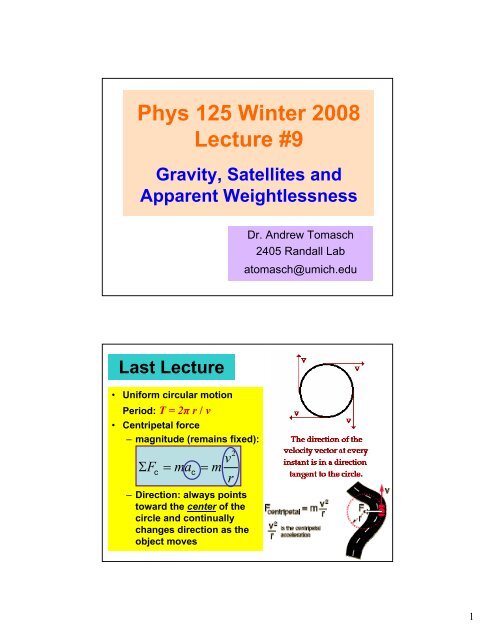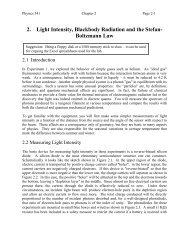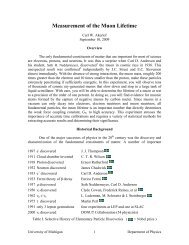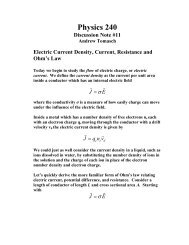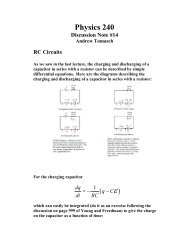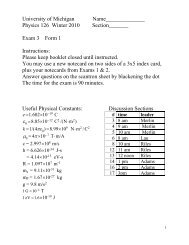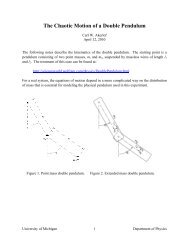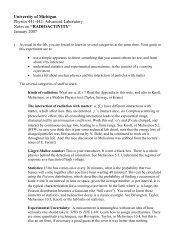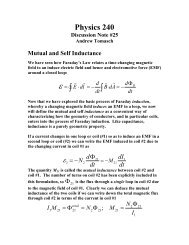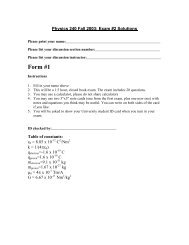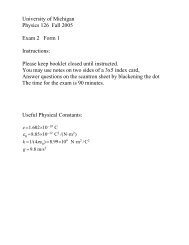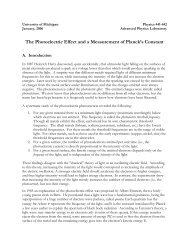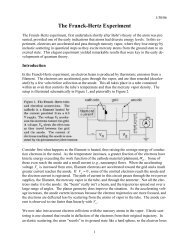Gravity, Satellites, Apparent Weightlessness
Gravity, Satellites, Apparent Weightlessness
Gravity, Satellites, Apparent Weightlessness
You also want an ePaper? Increase the reach of your titles
YUMPU automatically turns print PDFs into web optimized ePapers that Google loves.
Period & Frequency• Period - the time for one complete cycleof the motion:T2 π Rv• Frequency - number of revolutions persecond:f=1 =Tv2 π R=Non-UniformCircular Motion• If the forces don’tadd up to mv 2 /rdirected toward thecenter of the circle,the motion cannotbe uniform circularmotion• Example:Vertical circleshttp://www.physicsclassroom.com/mmedia/circmot/rcd.html2
CITY OF LA CENTERFEE SCHEDULE(ADOPTED DECEMBER 14, 2005)DESCRIPTION FEE 1Legal Lot DeterminationBase Fee $425Fee per lot over 2 lots$75/lotMixed Use Master PlanType III review$2,040 + Subdivision feesType II Site Plan approval $1,275Non Conforming UseDetermination $170Expansion or Alteration $850Planning Director ReviewType Use – Type I $170Code or zoning determination $170Plat AlterationsShort (4 lots or less) $340Long $680Project Review – Type I, II 4To $1,000 total costSee Site Plan Review$2,000 to $5,000 total cost See Site Plan Review$5,000 to $10,000 total cost See Site Plan ReviewOver $10,000 total costSee Site Plan ReviewProject Review – Type IIISee Site Plan ReviewPUD – Master PlanResidential – Base Fee$3,500 + subdivision feeFee per unit $125Site Plan Review (Project Review)Residential Type IResidential Type IINon Residential Type INon Residential Type IIType III or Binding Site Plan$170 + $85/lot$850 + $85/lot$425 + $85/ s.f.$1,275 + $85/1,000 s.f.$2,040 + hearing examinerand cost recoverySubdivisionsPreliminary Short (4 lots or fewer)$850 + $125/lot‣ Stormwater Review $150‣ Transportation/ROW review $100Engineering, plan review and construction inspection$250 + cost recovery4 The ‘Project Review’ process will be substantially amended during the 2006 code re-write project and will bereplaced by the Site Plan Review process.Page 3
How to Not Fall Off• If the speed is too low at the top, thenormal force required by Newton’sSecond Law will be zero or negative. Anegative normal force is not possibleunless the car and rider are attachedto the track (and each other!).• To not fall off: 2⇒vtopFN+ mg = m rFN≥0⇒2vtopFN= m −mg≥0rvtop≥grv topW = mg+ yF NIf v > gr the car stays on the loop.If v < gr the car falls off.If v = gr the car stays on theloop but the normal force vanishes atthe top → weightlessnessThe normal force is the apparent weight thatthe rider “feels” toward the bottom of the carrSwing the PailF N is the normal force of thebucket on the water → apparentweight of the water in the bucket• At the bottom of the loop:2 2vbotvbotFN-bottom− mg = m ⇒ FN-bottom= m + mgrr• At the top of the loop:2 2vtopvtopFN-top+ mg = m ⇒ FN-top= m −mgrrIf F N-top < 0 (v top is too slow) the rope goes slack andthe water falls out of the bucket and onto my head.Therefore v top should be:vtop≥gr4
Circular Motion and <strong>Gravity</strong>• Combine Newton's two greatestachievements: laws of motion andthe description of gravity• Two simplifying assumptions:1. The orbit is circular. This case is much easier todeal with mathematically. The orbits of mostobjects in the solar system, including the earth,are in fact slightly elliptical.2. The mass of one object is much less than themass of the other. This assumption allows us toneglect the gravitational force of the light objecton the heavy one, and pretend that the heavyobject stays fixed at the center while the light oneorbits around it.A Satellite is a Projectile• If you launch a projectile fastenough (equal to 8000 m/s) theearth curves away from it as itfalls and it goes into orbit.• A satellite is a projectile whichfalls around the earth instead ofinto it.• A satellite is in free fall towardthe earth. Objects aboard anorbiting satellite thereforeexperience apparentweightlessnessv < 8000 m/sv = 8000 m/shttp://www.glenbrook.k12.il.us/gbssci/phys/mmedia/vectors/sat.html5
<strong>Weightlessness</strong>: Free Fall• Suppose for a rocket flying awayfrom the Earth’s center, the rocketthrust is decreased so that therocket falls back toward the Earthwith acceleration a• The astronaut feels the floorpushing up on him with a forceequal to F N = m (g-a) (exactly thesame as the elevator problem).• Now suppose the thrust is reducedto zero and the rocket begins tofree fall toward the Earth → a = g →F N = m (g-a) = 0 and the astronautexperiences weightlessness.• This holds true for any object infree fall including objects in orbit.• Einstein’s Equivalence Principle →General RelativityNormalforce F NmaIf a = g = 9.8 m/s 2 →F N = 0 <strong>Weightlessness</strong>An Orbiting Satellite• A satellite of mass m in acircular orbit around aplanet of mass M• <strong>Gravity</strong> provides thecentripetal force:g(r)GMm v2 m orbitr rv orbit2= CentripetalAccelerationrmM6
Artificial <strong>Gravity</strong>:Accelerationa = g = 9.8 m/s 2• Now accelerate the rocket in space (nogravity present) with a = 9.8 m/s 2• The astronaut feels the floor pushing upon him with a normal force F N = ma = mg• Now suppose the astronaut in the boxdrops a pencil:To him it looks like the pencil has “fallen” tothe floor with an acceleration of 9.8 m/s 2because the floor of the box continues toaccelerate at 9.8 m/s 2 toward the pencil• There is no way that the astronaut cantell by this type of experiment if he is atrest on earth or accelerating uniformlyout in space.• Einstein’s Equivalence Principle →General RelativityNormalforce F NmaArtificial <strong>Gravity</strong>:Centripetal Acceleration• Uniform acceleration in astraight line is one way toproduce artificial gravity,but it's not very practical• It's more practical tomake the accelerationcentripetal and produceartificial gravity by rotation• If r =100 m, v = 31 m/s= 60 mph2vFC= FN= m = mgr⇒ v=gr9
<strong>Apparent</strong> <strong>Gravity</strong>:The Number of g’s• Another way to expressapparent gravity is todetermine the apparentweight in terms of theapparent gravitationalacceleration measured inunits of the Earth’sgravitational acceleration• This is commonly referredto as “the number of g’s”<strong>Apparent</strong> Weight FN# g ≡ =True Weight mgFor circular motion:2vFN= Fc= m r2 2mv 1 v⇒ # g = = ( m divides out)r mg rg# g = 1⇒ v=rg as beforeArtificial <strong>Weightlessness</strong>• The gravitational forceof the earth acting onyou is always mg andthere's nothing you cando to remove it• But you can gain theeffect of weightlessnessin free fall• To train astronautsNASA flies a plane forshort times on a free-falltrajectoryNASA's KC-135 - The Vomit Comet10
NASA’s Zero-<strong>Gravity</strong> Training• At the topmg − F = maif acthenN= gFNc= 0 ⇒<strong>Weightlessness</strong>Today’s Homework• WileyPlus Homework #4 is due 11:00 pmthis Friday February 8• WileyPlus Homework #5 is due 11:00 pmnext Wednesday February 13• Assigned Conceptual Questions &Problems from Textbook• Print tomorrow’s discussion worksheet11


